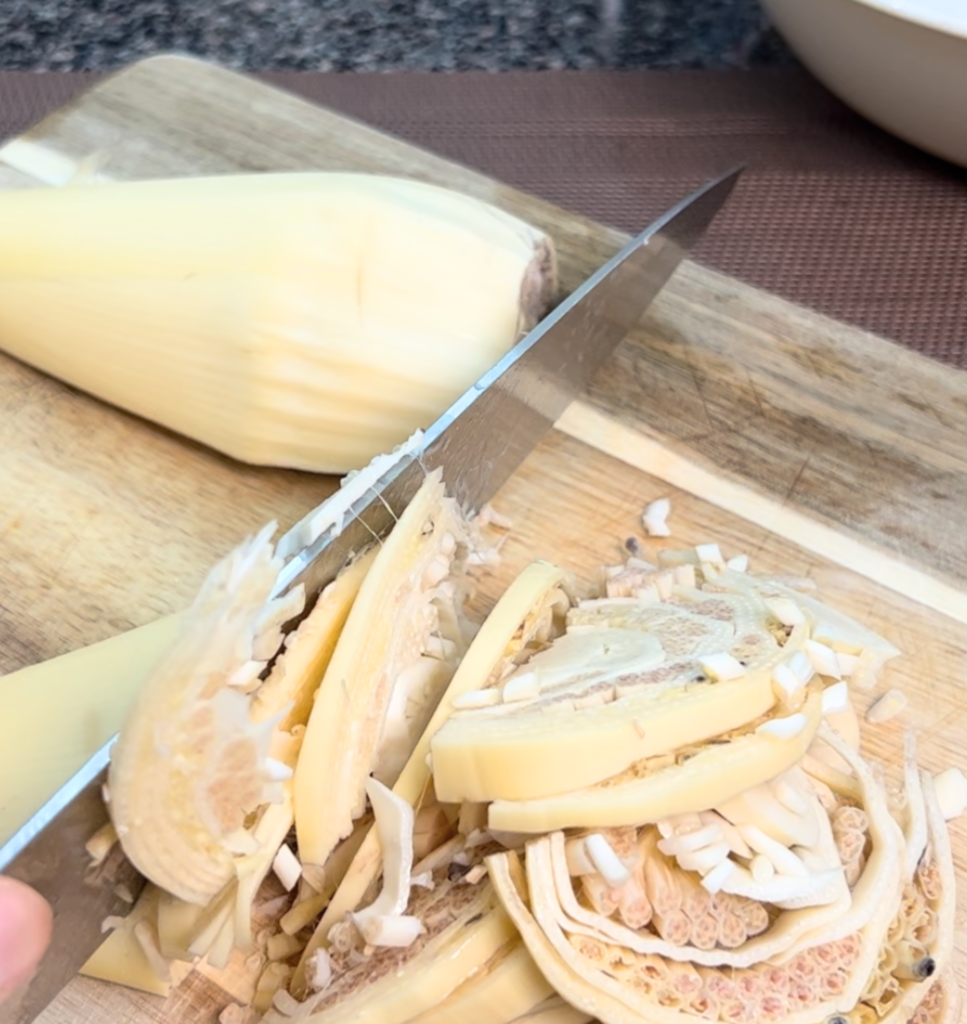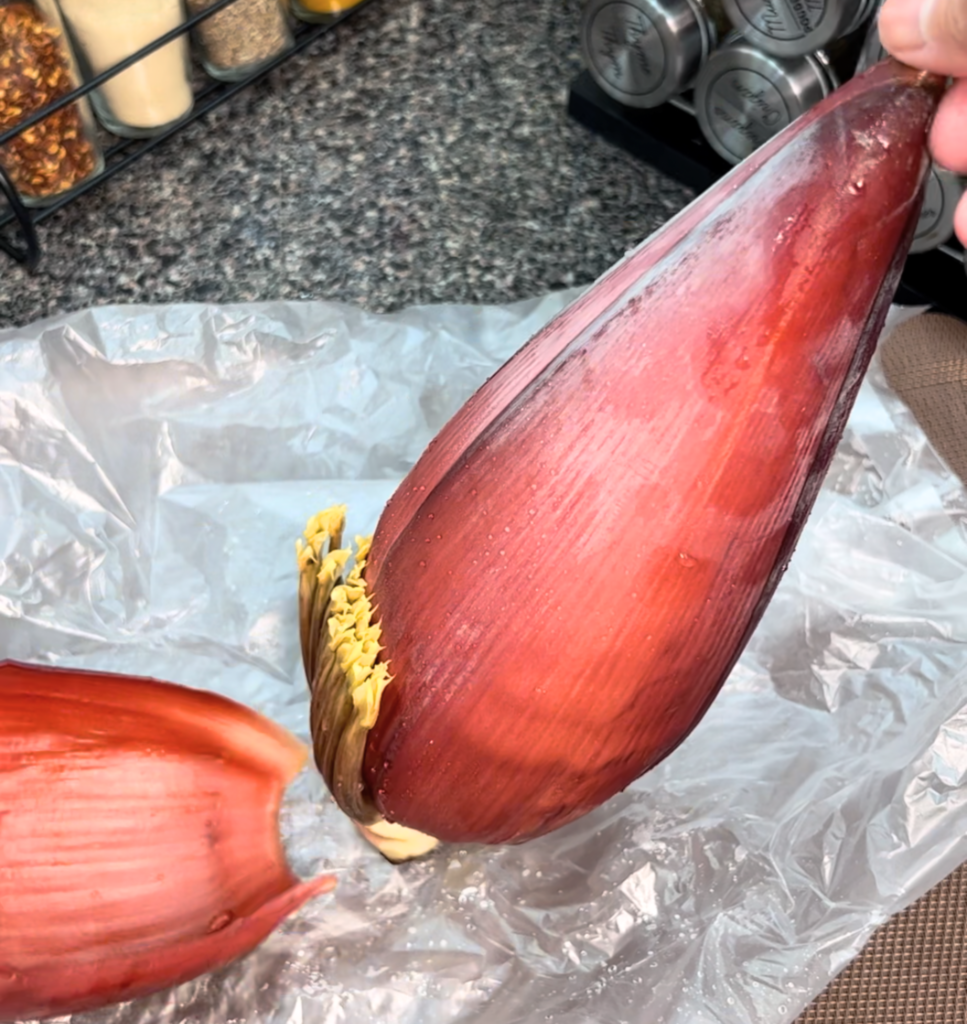
Table of Contents
ToggleWhy I Love This Dish
I love this dish because it’s healthy, and banana blossom has been a part of my life since I was a kid. My mom always encouraged us to eat healthy, introducing us to all sorts of vegetables—banana blossom was one of them. It’s not a vegetable you find everywhere, but we were lucky that our neighbor had banana trees. When the blossoms were in season, they would give us some, and my mom would either cook them right away or freeze them for later meals.
Now that I live abroad, I still make this dish, but things are a little different. I buy banana blossoms from the Asian store, where they can cost between $6 to $10 each. It’s a bit expensive, but worth it. I use canned coconut milk now instead of fresh, which makes it more convenient while keeping the same great taste.
Whenever I prepare this dish, I remember the lessons my mom taught me about eating healthy and making the most of what we have. I still apply what I learned from her in my own cooking, even though I live far from home now. It’s a simple way to stay connected to the healthy habits she passed on to me.
Why You’ll Love This Dish
You’ll love this dish because it takes a simple, often overlooked ingredient—banana blossoms—and turns it into something flavorful and unique. When simmered in creamy coconut milk, the slight bitterness of the banana blossoms blends perfectly with the richness of the sauce. Add in onions, garlic, and ginger, and you get a dish that’s both comforting and full of flavor. If you enjoy a bit of heat, you can throw in fresh chili, but it’s easy to adjust the spice level to your liking.
This dish is also versatile. Whether you serve it as a side or let it shine as the main course, sautéed banana blossom with coconut milk brings something special to the table. It’s a traditional Filipino favorite that’s easy to make, even if you’re new to cooking with banana blossoms. Plus, the simple ingredients make it approachable, while still offering exciting new flavors to try.

What Are Banana Blossoms?
Banana blossoms may seem unfamiliar, but they’re such a versatile vegetable once you know how to use them. They grow at the end of a banana bunch, but unlike the fruit, they have a mild, nutty flavor. I didn’t think much of them as a kid, but now I realize how special they are, especially since they’re a staple in Filipino and Southeast Asian cooking. I love how banana blossoms bring something new and different to my meals.

The Health Benefits of Banana Blossoms
Growing up, my mom always stressed eating nutritious food, and banana blossoms were part of that. They’re high in fiber, which helps with digestion, and packed with vitamins like A, C, and E. They’re also rich in minerals like potassium and magnesium. I like knowing that while I’m enjoying this dish, I’m also getting good nutrients. Plus, it’s believed they help reduce inflammation and can even support healthy blood pressure—something my mom always mentioned.
How to Prepare Banana Blossoms
Prepping banana blossoms is key to getting them just right in a dish. You’ve got to peel off the tough outer layers until you reach the softer inner part. Once you slice them, I recommend soaking them in water with a bit of salt and vinegar for 15-20 minutes. This helps to reduce bitterness and makes them much more pleasant to eat. After soaking, rinse them well and you’re all set to start cooking. This trick has always worked for me, and I definitely notice the difference when I skip the soaking step.
Coconut Milk and Banana Blossoms: A Great Combo
One of the best ways to cook banana blossoms is to simmer them in coconut milk. Coconut milk adds a rich, creamy texture to the dish and balances out any slight bitterness from the banana blossoms. It’s a simple combination, but one that works every time. The mild flavor of the blossoms really lets the coconut milk shine without overpowering it.
Slow Cooking for Best Results
Banana blossoms need a bit of time to soften when you cook them. I’ve found that simmering them for about 15-20 minutes is perfect. If they’re undercooked, they can stay tough and chewy, which isn’t great. When they’re cooked just right, they become tender but still hold their shape. It’s a simple step, but one that makes a big difference in the final dish.
Adding Pork for Extra Flavor
In many banana blossom dishes, pork is often added for some extra flavor. I like using pork belly because the fat from the pork adds a richness that works really well with the coconut milk. You brown the pork first to get a nice sear, then set it aside while you sauté the onion, garlic, and ginger. Once everything’s smelling great, you add the pork back in with the banana blossoms and coconut milk. It’s a great combination, but if you want to keep it lighter, shrimp or even tofu would be good options, too.
Adjust the Spice to Your Liking
If you like a bit of spice, banana blossoms pair well with green chilies. I usually add a couple for a little heat, but you can adjust the amount based on your preference. If you’re not into spicy food, just leave the chilies out. It’s one of those dishes that you can easily tweak to fit your tastes.
What to Serve with Banana Blossoms
I usually serve this dish with steamed rice. The rice soaks up all that creamy coconut milk sauce, making it a satisfying meal. You can also pair it with other simple sides, like grilled fish or a light vegetable stir-fry. I’ve even served it with a cucumber salad before, which adds a nice fresh contrast to the richness of the coconut milk.

Tips for Cooking Banana Blossoms at Home
- Choose Fresh Blossoms: When selecting banana blossoms, look for ones that are firm and free of blemishes. The outer leaves should be a deep purple, and the inner layers should be pale and tender.
- Soak Before Cooking: Always soak your banana blossoms in salt and vinegar water to remove bitterness and soften them up.
- Balance Your Flavors: The mildness of banana blossoms pairs well with bold flavors like garlic, ginger, coconut milk, and chilies. Don’t be afraid to season generously.
- Experiment with Proteins: Pork is a traditional choice, but feel free to experiment with shrimp, chicken, or even tofu for a vegetarian version.
Key Indicators for Properly Cooked Banana Blossom
- Tenderness: The banana blossom should be soft and tender, not chewy or fibrous.
- Reduced Bitterness: The soaking process should significantly reduce bitterness. Taste the banana blossom during cooking to ensure it is not overly bitter.

Sauteed Banana Blossom
Ingredients
- 1 banana blossom, peeled and sliced
- 1/2 pound pork belly, sliced into small pieces (or any pork cut)
- 1 onion, chopped
- 3 cloves garlic, minced
- 1 thumb-sized piece of ginger, sliced
- 1 cup coconut milk
- 1 tablespoon fish sauce (adjust to taste)
- 1-2 green chilies, sliced (optional)
- Salt and vinegar (for soaking the banana blossoms)
- Cooking oil
Instructions
- In a pan, heat a little cooking oil over medium heat. Add the sliced pork belly and brown it on all sides until crispy and cooked through. Once browned, remove the pork and set it aside.
- Using the same pan and the pork fat, sauté the chopped onion until soft. Add the minced garlic and ginger, and sauté until fragrant.
- Add the prepared banana blossoms to the pan and cook for 2-3 minutes, stirring well.
- Pour in the coconut milk and bring it to a simmer. Add the fish sauce and stir everything together.
- Return the browned pork to the pan and let everything simmer for about 15-20 minutes, or until the banana blossoms are tender and the coconut milk has reduced slightly.
- For a bit of heat, add the sliced green chilies and stir to combine.
- Serve hot with steamed rice.










One Response
Testing